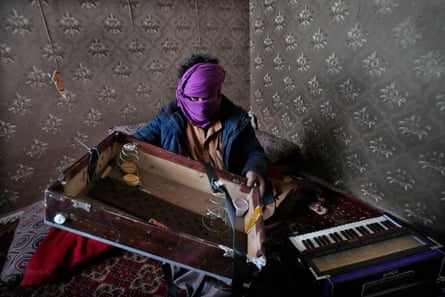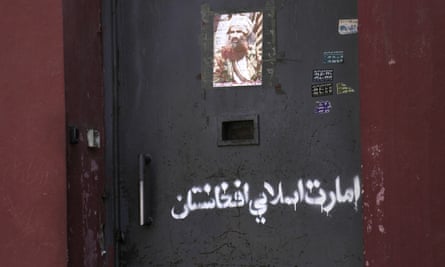Art
When the music stops: how the Taliban’s fear of art is killing Afghan culture
When the Taliban moved closer to Kabul in the early days of August 2021, a series of unusual advertisements flooded the shopping pages on Afghan social media. Musicians were putting their instruments and equipment – the tools of their trade – up for sale.
Many were being offered for a fraction of what they were worth. Yet, even in a country with an immense love for music, there were few buyers. “I knew from past experience what they would do with people like us [musicians], and our instruments. They have a dislike for our art and culture,” a 49-year-old singer from the north of Afghanistan who wished only to be identified as Farhan, told the Guardian.
Farhan was a sought-after musician in his town during festivals, weddings and social gatherings for his mesmerising renditions of folk songs played on a damboora, a traditional Afghan musical instrument. But when the insurgents marched closer to his city, he started receiving calls and social media messages from Taliban commanders accusing him of causing “moral corruption”.

“I knew they would not spare me, so I had to say farewell to my instruments and leave the country,” he says. Some musicians tried to sell their instruments, he adds, while others destroyed them rather than letting them fall into the hands of the Taliban. “I buried my instruments in the fields.”
It was foresight that saved Farhan’s life. Some of his colleagues, such as the folk singer Fawad Andarabi, were less fortunate, murdered by the Taliban just weeks after the group seized power.
Since taking over, the Taliban have imposed their rigid interpretation of Islam, restricting and even criminalising music and arts – some of the most integral aspects of Afghan culture.
In July, the Taliban’s ministry for promotion of virtue and prevention of vice shared photos of a bonfire of “illegal” musical instruments that had been seized.
While setting the equipment on fire, Aziz Rahman Muhajir, head of the vice and virtue department in Herat, once again reminded Afghans that the sale of musical instruments was a punishable offence.
When Farhan saw the images, he was heartbroken. “It felt as if they were burning parts of my body. My soul was on fire.”

“Of the many aspects of life affected by the war in Afghanistan, I would say art and culture are among the worst affected,” says Omaid Sharifi, co-founder of ArtLords, a collective that has worked to revive Afghan art and culture since 2014.
The group continues to operate in exile as well as through discreet artist networks within Afghanistan. “When the Soviets came, they tried to promote their own narratives about Afghan culture. They were followed by the mujahideen groups, and the first thing they did when they took over Kabul was to loot the national museum. It was the frontline of their civil war,” he says.
The Taliban followed soon after, Sharifi says, and they were the worst of all. “Art and culture does not exist in their minds; they blew up the Buddhas of Bamiyan and other statues, destroyed precious artworks and, of course, musical instruments.”
In the two decades after the fall of the Taliban’s first administration in 2001, Afghan art, music and culture not only revived but thrived. Artists brought out their paint brushes, music was created and taught to the younger generation in places such as the Afghanistan National Institute of Music, where the first Afghan female orchestra was formed.
“It quickly emerged as a renaissance of its own,” says Sharifi. “Afghans welcomed it and participated in creating new art, music and other forms of culture, to express their feelings, to inspire hope and to feel happy.”

Art, poetry, music are fundamental to Afghan identity. “If you dig five metres in any part of this country, you will find some artefact that shows it’s connection to art and music,” says Sharifi.
It wasn’t uncommon for friends to get together on Thursday evenings (a weekend in Afghanistan) for a social gathering, accompanied by endless cups of chai and a symphony of music played by professional musicians such as Farhan.
“It gave us hope that even in times of conflict, when people get a chance they were willing to break away from the cycle of violence to engage with their culture. We were making progress but we lost it all, back to almost zero,” Sharifi says.
And the longer the Taliban control Afghanistan, Farhan warns, the deeper the country will sink into “cultural poverty”. “Just as they have closed the gates of universities and schools to women – which is half of our society – this is another act that will destroy the country,” he says.

The Taliban’s dislike for music and art, Sharifi says, comes from its power to transform mindsets. “It can inspire change among the people. It can make people think critically and ask questions, which they are afraid of. But most of all, it can make people hopeful – that’s the power of art and music. And when you are hopeful, you will try to change yourself, your community, your environment – and they are really afraid of this.”
Farhan adds: “Because art itself evokes a kind of awakening and freedom in societies. Music especially can tie people from different parts of society together, bringing them closer, more united. So it is no surprise that they fear the art and music.”
“Art and music are a threat to their terror regime,” says Sharifi. “This land, this country has been at a crossroads of cultures throughout history, and I don’t think it will be easy for groups like the Taliban to completely take that away. They cannot force a whole country to abandon its identity.”

Art
Calvin Lucyshyn: Vancouver Island Art Dealer Faces Fraud Charges After Police Seize Millions in Artwork

In a case that has sent shockwaves through the Vancouver Island art community, a local art dealer has been charged with one count of fraud over $5,000. Calvin Lucyshyn, the former operator of the now-closed Winchester Galleries in Oak Bay, faces the charge after police seized hundreds of artworks, valued in the tens of millions of dollars, from various storage sites in the Greater Victoria area.
Alleged Fraud Scheme
Police allege that Lucyshyn had been taking valuable art from members of the public under the guise of appraising or consigning the pieces for sale, only to cut off all communication with the owners. This investigation began in April 2022, when police received a complaint from an individual who had provided four paintings to Lucyshyn, including three works by renowned British Columbia artist Emily Carr, and had not received any updates on their sale.
Further investigation by the Saanich Police Department revealed that this was not an isolated incident. Detectives found other alleged victims who had similar experiences with Winchester Galleries, leading police to execute search warrants at three separate storage locations across Greater Victoria.
Massive Seizure of Artworks
In what has become one of the largest art fraud investigations in recent Canadian history, authorities seized approximately 1,100 pieces of art, including more than 600 pieces from a storage site in Saanich, over 300 in Langford, and more than 100 in Oak Bay. Some of the more valuable pieces, according to police, were estimated to be worth $85,000 each.
Lucyshyn was arrested on April 21, 2022, but was later released from custody. In May 2024, a fraud charge was formally laid against him.
Artwork Returned, but Some Remain Unclaimed
In a statement released on Monday, the Saanich Police Department confirmed that 1,050 of the seized artworks have been returned to their rightful owners. However, several pieces remain unclaimed, and police continue their efforts to track down the owners of these works.
Court Proceedings Ongoing
The criminal charge against Lucyshyn has not yet been tested in court, and he has publicly stated his intention to defend himself against any pending allegations. His next court appearance is scheduled for September 10, 2024.
Impact on the Local Art Community
The news of Lucyshyn’s alleged fraud has deeply affected Vancouver Island’s art community, particularly collectors, galleries, and artists who may have been impacted by the gallery’s operations. With high-value pieces from artists like Emily Carr involved, the case underscores the vulnerabilities that can exist in art transactions.
For many art collectors, the investigation has raised concerns about the potential for fraud in the art world, particularly when it comes to dealing with private galleries and dealers. The seizure of such a vast collection of artworks has also led to questions about the management and oversight of valuable art pieces, as well as the importance of transparency and trust in the industry.
As the case continues to unfold in court, it will likely serve as a cautionary tale for collectors and galleries alike, highlighting the need for due diligence in the sale and appraisal of high-value artworks.
While much of the seized artwork has been returned, the full scale of the alleged fraud is still being unraveled. Lucyshyn’s upcoming court appearances will be closely watched, not only by the legal community but also by the wider art world, as it navigates the fallout from one of Canada’s most significant art fraud cases in recent memory.
Art collectors and individuals who believe they may have been affected by this case are encouraged to contact the Saanich Police Department to inquire about any unclaimed pieces. Additionally, the case serves as a reminder for anyone involved in high-value art transactions to work with reputable dealers and to keep thorough documentation of all transactions.
As with any investment, whether in art or other ventures, it is crucial to be cautious and informed. Art fraud can devastate personal collections and finances, but by taking steps to verify authenticity, provenance, and the reputation of dealers, collectors can help safeguard their valuable pieces.
Art
Ukrainian sells art in Essex while stuck in a warzone – BBC.com
[unable to retrieve full-text content]
Ukrainian sells art in Essex while stuck in a warzone BBC.com

Source link
Art
Somerset House Fire: Courtauld Gallery Reopens, Rest of Landmark Closed
The Courtauld Gallery at Somerset House has reopened its doors to the public after a fire swept through the historic building in central London. While the gallery has resumed operations, the rest of the iconic site remains closed “until further notice.”
On Saturday, approximately 125 firefighters were called to the scene to battle the blaze, which sent smoke billowing across the city. Fortunately, the fire occurred in a part of the building not housing valuable artworks, and no injuries were reported. Authorities are still investigating the cause of the fire.
Despite the disruption, art lovers queued outside the gallery before it reopened at 10:00 BST on Sunday. One visitor expressed his relief, saying, “I was sad to see the fire, but I’m relieved the art is safe.”
The Clark family, visiting London from Washington state, USA, had a unique perspective on the incident. While sightseeing on the London Eye, they watched as firefighters tackled the flames. Paul Clark, accompanied by his wife Jiorgia and their four children, shared their concern for the safety of the artwork inside Somerset House. “It was sad to see,” Mr. Clark told the BBC. As a fan of Vincent Van Gogh, he was particularly relieved to learn that the painter’s famous Self-Portrait with Bandaged Ear had not been affected by the fire.
Blaze in the West Wing
The fire broke out around midday on Saturday in the west wing of Somerset House, a section of the building primarily used for offices and storage. Jonathan Reekie, director of Somerset House Trust, assured the public that “no valuable artefacts or artworks” were located in that part of the building. By Sunday, fire engines were still stationed outside as investigations into the fire’s origin continued.
About Somerset House
Located on the Strand in central London, Somerset House is a prominent arts venue with a rich history dating back to the Georgian era. Built on the site of a former Tudor palace, the complex is known for its iconic courtyard and is home to the Courtauld Gallery. The gallery houses a prestigious collection from the Samuel Courtauld Trust, showcasing masterpieces from the Middle Ages to the 20th century. Among the notable works are pieces by impressionist legends such as Edouard Manet, Claude Monet, Paul Cézanne, and Vincent Van Gogh.
Somerset House regularly hosts cultural exhibitions and public events, including its popular winter ice skating sessions in the courtyard. However, for now, the venue remains partially closed as authorities ensure the safety of the site following the fire.
Art lovers and the Somerset House community can take solace in knowing that the invaluable collection remains unharmed, and the Courtauld Gallery continues to welcome visitors, offering a reprieve amid the disruption.
-

 Sports22 hours ago
Sports22 hours agoEdmonton Oilers sign defenceman Travis Dermott to professional tryout
-

 Sports15 hours ago
Sports15 hours agoKirk’s walk-off single in 11th inning lifts Blue Jays past Cardinals 4-3
-

 Sports21 hours ago
Sports21 hours agoCanada’s Sarah Mitton captures shot put gold at Diamond League in Brussels
-

 Sports21 hours ago
Sports21 hours agoAnother player from top-ranked Georgia arrested for reckless driving
-

 News21 hours ago
News21 hours agoOpinions on what Tagovailoa should do next vary after his 3rd concussion since joining Dolphins
-

 News21 hours ago
News21 hours agoAustralia’s Michael Matthews earns third win at Quebec cycling GP
-

 News20 hours ago
News20 hours agoKamloops, B.C., man charged with murder in the death of his mother: RCMP
-

 Sports21 hours ago
Sports21 hours agoWhitecaps loan Herdman to CPL’s Cavalry, sign two reserve players to first-team deals




















